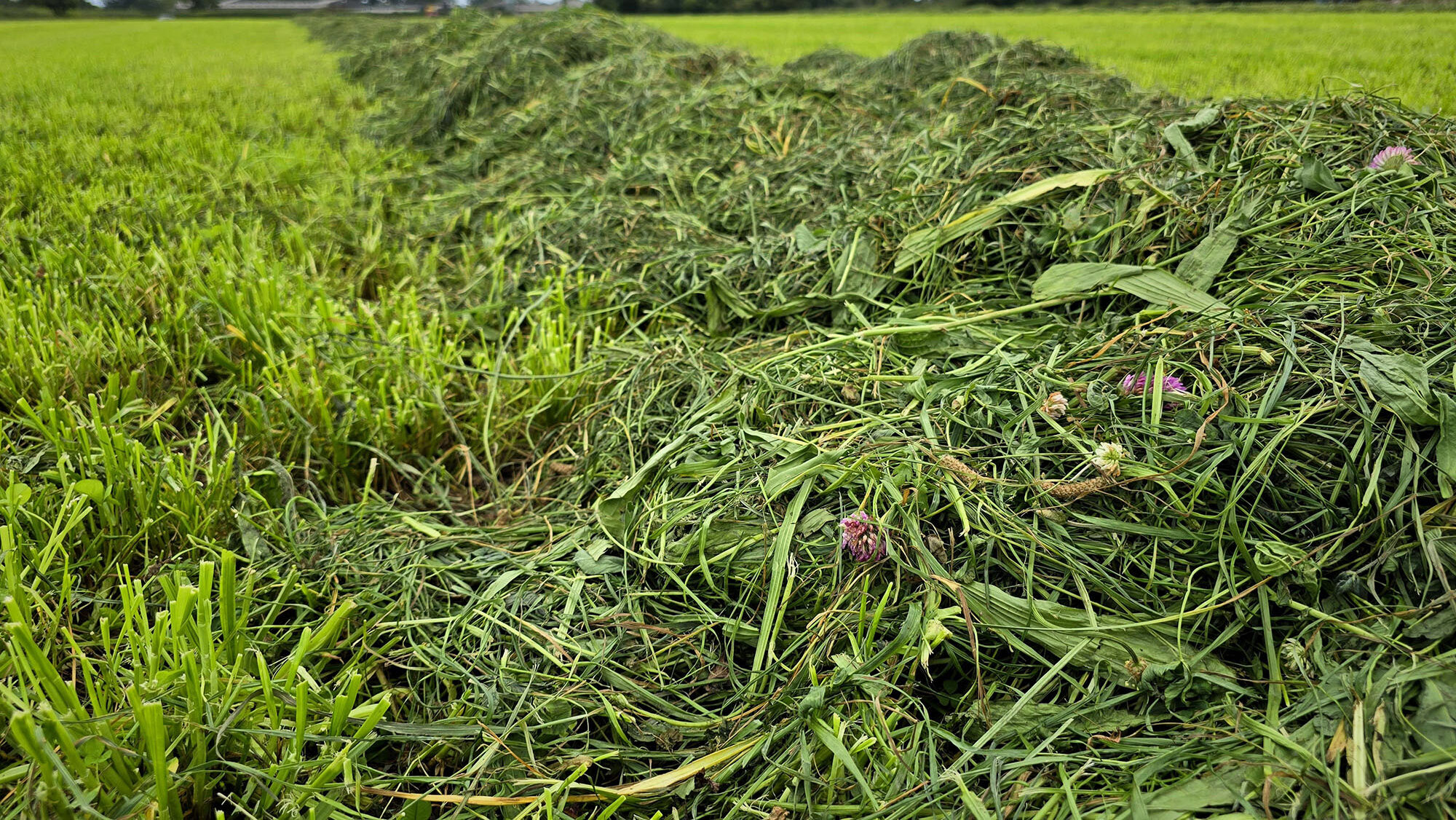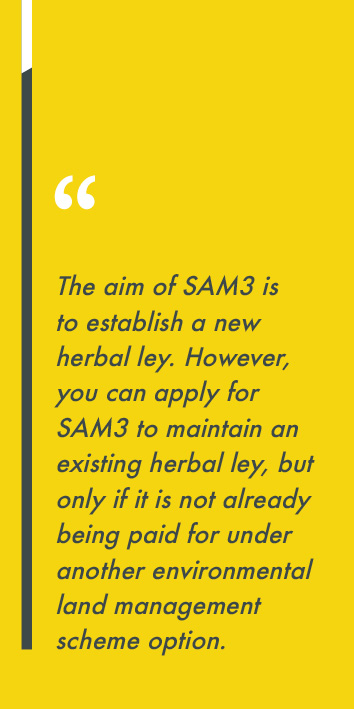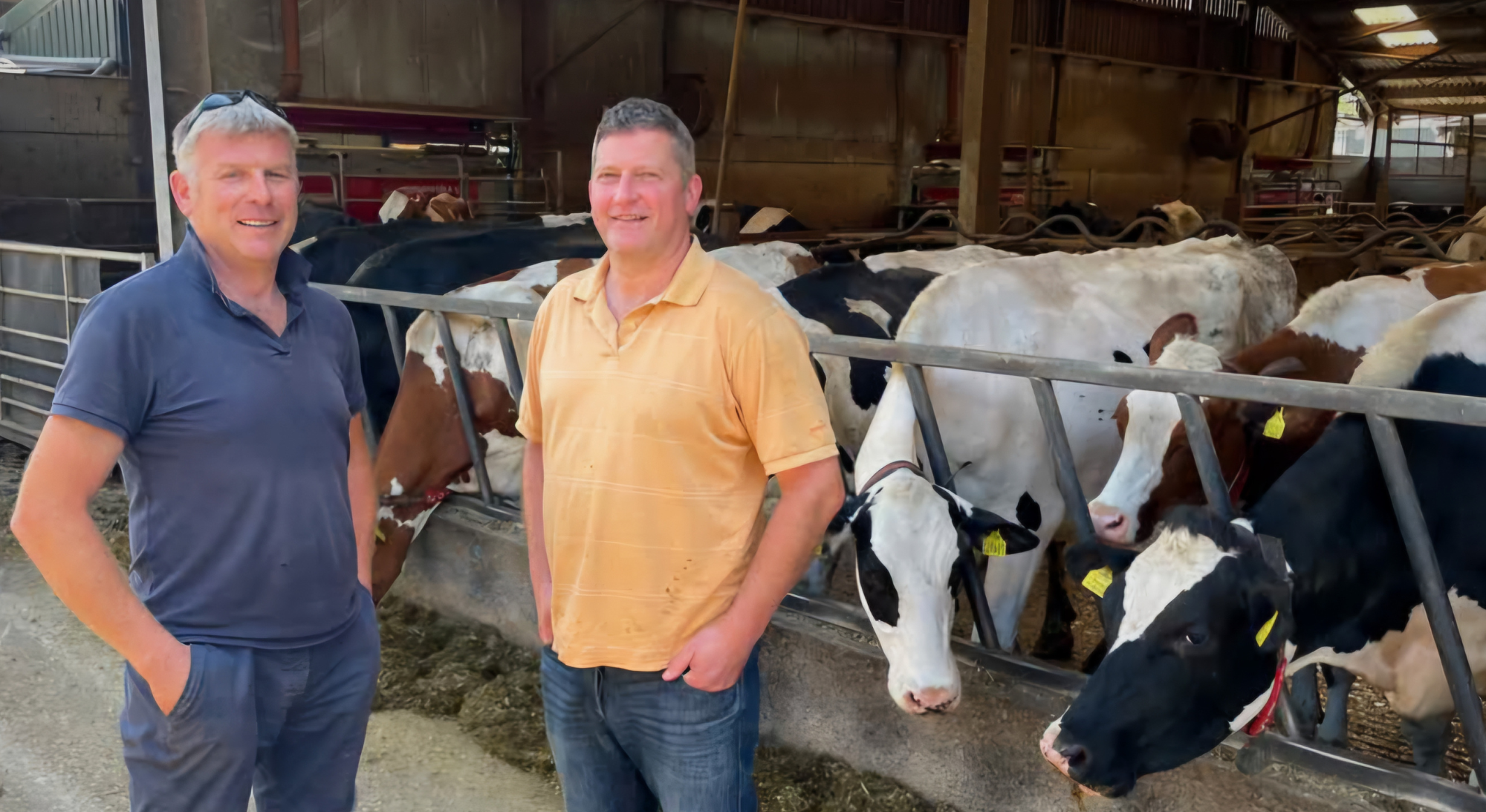Thinking more about the role of SAM3 herbal leys and choosing the best option for your own individual farming set-up could deliver benefits far beyond those resulting from the SFI payment alone.

Not all SAM3 herbal leys are the same. Producers choosing the least cost seed simply to tick the SFI box required for the payment could be losing out on many of the real benefits associated with them, says Agrii grass, roots and environmental seeds manager Adam Simper.
Make the right choices, and not only will you be adding highly valuable diversity to forage security throughout the year, but you’ll also see improvements in soil health, organic content and structure, as well as long-term productivity gains, he believes.
“Herbal leys are definitely growing in popularity largely as a result of government funding under the Sustainable Farming Incentive (SFI) and a growing awareness of their environmental benefits.
“But for many tempted to start using them, it’s a completely new area of management and one which is further confused by an ever-growing range of mixes on offer together with a variety of claims made for these.
“It’s far from a ‘one size fits all’ situation and while there are significant opportunities for improving livestock health and performance alongside soil health, carbon capture and biodiversity benefits, this does depend on their successful integration into existing systems.“
Understanding the different options
The starting point for this is to make sure you understand the different options open to you and the merits of the various approaches available, he stresses.
“Herbal leys can be made up of a wide mixture of grasses, legumes and herbs, with their strength lying in this diversity.
“The right mixture of species can create a varied and nutrient-rich diet for livestock due to deep rooted species mining minerals from the soil’s depth and making them available via the forage.
“Furthermore, this can be either be as grazing in the summer months or as a silage that can be fed to livestock year-round.
“When it comes to soil improvement, a carefully prepared mixture of species can ensure roots penetrate to different levels, dramatically improving soil structure, and helping prevent leaching, while increasing moisture and nutrient retention.
“This in turn helps capture carbon, improves organic matter content and boosts the health of your soil. The legumes in herbal leys also fix nitrogen, which increases the nutrient value of the soil, helping to reduce costly fertiliser applications.“
If this is not enough, the correctly specified herbal ley mixture can increase biodiversity, support a wide range of beneficial insects and wildlife, and improve the whole farm’s ecosystem, Adam Simper points out.
“The diversity of swards from multiple plant species can bring strength and improve pest resistance by disrupting pest life cycles.
“But to enjoy all these benefits you must make sure the mixture you choose is suited to your livestock and your land.“
To get the widest range of benefits, producers should select something with a diverse mix of grasses, legumes, and herbs suited to your whole farm enterprise, he urges.
“Under the 2023 SFI scheme, the voluntary guidance for SAM3 asked farmers to include five grass species, three legume species and five herbs, whereas the 2024 CSAM3 mix requires a minimum of one grass, two legumes and two herbs.
“It also stipulates you must minimise the use of inorganic fertilisers containing nitrogen, which is usually set at no more than around 40kg N/ha in any year.
“Common species in herbal leys include Ryegrass, Timothy, Fescues, Cocksfoot, Festulolium, Red and White clover, Birdsfoot Trefoil, Chicory, Plantain, Sheeps Burnet, Sheeps Parsley, and Yarrow.“
A wide range of options
Agrii has a range of mixes designed to fit SFI requirements, ranging from those aimed at delivering maximum forage production for livestock to others specifically created for overseeding to increase the diversity of the sward, he explains.
“Each farm’s management regime will be different so it’s a good idea to speak to an Agrii specialist who can advise you on which mix will best suit your specific needs.

“Agrii SFI SAM3 Grazing, for example, has been designed to produce high yields of good quality forage for all livestock.
“The inclusion of AberZeus Intermediate Diploid helps to create a dense sward, and along with the legumes and herbs, provides a resilient, valuable, and nutrient-rich forage during periods of dry weather.
“Then there’s Agrii SFI SAM3 Cutting, which produces large cuts of quality silage, providing a highly palatable forage with variety when fed.
“As Chicory can become woody and cause fermentation issues when baled and wrapped with woody stems easily piercing film, this cutting-based mix does not include Chicory.
“Agrii SFI SAM3 No Red Clover has been formulated for the grazing of livestock to avoid potential bloat in cattle when grazed and fertility issues in breeding ewes resulting from the inclusion of red clover.
“In particular, the varied species within the formulation provide a resilient, valuable, and nutrient-rich forage during periods of dry weather.“
Agrii SFI SAM3 Overseeding can be drilled into existing pastures where the objective is to increase the population of grass, legumes, and herb species within the sward, Adam Simper points out.
“As with all overseeding, any thatch in the base of the existing sward should be removed to allow good seed-to-soil contact and to also enhance light penetration.
“The Agrii Legume and Herb Overseeding Pack will also increase the legume and herb content in any existing sward.
“Again, all thatch should be removed to allow good seed-to-soil contact and light penetration and it is not advised to apply nitrogen until the newly sown species are established as this will only increase competition from the existing grasses.“
Understanding SAM3 requirements
The SFI scheme has proven particularly attractive as it can run alongside other Government programmes, ensuring producers can extract more value from their land, Adam Simper points out.
“The objective of the SAM3 option is focused on improving soil structure and helping to increase carbon capture while boosting soil biology and fertility.
“Under the scheme, you can claim £382 per hectare and eligible land includes arable land along with temporary and permanent grassland.
The aim of SAM3 is to establish a new herbal ley. However, you can apply for SAM3 to maintain an existing herbal ley, but only if it is not already being paid for under another environmental land management scheme option.
“The CSAM3 option differs slightly in that its aim is to establish a herbal ley with a mixture of grasses, legumes and herbs or wildflowers that will produce a high volume of forage with minimal use of inorganic fertiliser.
“The scheme also aims to help make land more drought resilient while improving and maintaining the soil’s structure, carbon, biology and fertility.
“Under CSAM3, the minimum number of species you can include to meet the requirements of the scheme are one grass species, two legumes and two herbs, but you will get greater diversity by adding more species.
“Again, you can claim £382 per hectare and eligible land includes arable land, arable land lying fallow and temporary and permanent grassland.
“With the CSAM3 option, you are required to establish the herbal ley by early autumn, within 12 months of this action’s start date, and it must then be carefully maintained at the same location until the objectives of the action can be achieved.
“The guidance suggests this would be the end of the second summer after sowing. After this time, you do have the option to rotate the herbal ley to another part of the farm.
“You are also expected to re-establish the herbal ley by early autumn (either at the same location or a different location) and maintain it until the action’s end date.“
Scheme requirements
The SFI scheme has several key requirements, including keeping records and evidence, such as receipts for your seed mix and any other relevant documentation, to show that you are performing the required actions, he explains.
“Under both options, you must maintain the ley and this can be done by grazing or cutting. It is also advised that you leave leys untouched for at least five consecutive weeks between early May and late July to provide pollen and nectar for insects.
“While rotation is an option, it’s also important to ensure the herbal ley achieves the objective of improving soil health, so make sure the soil structure has benefited from the herbal ley before moving on and be prepared to overseed if any area fails.“
Under CSAM3, there are also strict restrictions on the amount of inorganic fertilisers you can use, with guidance saying no more than 40kg N/ha should be applied in any one year, he points out.
“With both options, the use of herbicides and pesticides is also restricted with herbicides only being used to weed wipe or spot treat injurious weeds, invasive non-native species, nettles or bracken.“
Even without Government funding, herbal leys are a valuable addition to a farming operation, Adam Simper stresses.
“They can create a nutrient-rich and balanced diet that will improve livestock health and performance while also helping to improve soil and biodiversity and cutting fertiliser inputs.
“So, spend the time to find out what approach to herbal leys is going to work best in your own farming situation, learn about their management and talk to your Agrii specialist to work out the best mix to help you achieve your objectives.“
Case study: maintaining forage production whilst embracing SFI opportunities

Many growers across England have engaged with SFI and have already begun the process of stitching many of the new schemes into their existing farming practices.
One such farmer is Andrew Griffiths of Bulls Green Farm, Cheshire who runs a fully robotic system milking 390 cows and averaging 38.5 litres per day.
“They have slotted in well within our system, yielded as well as our existing Multi Master swards and the diversity within them is great to see and should give us more future resilience during periods of dry weather. We have recently started feeding Silage produced from our Agrii SAM3 Cutting leys which has returned at 19% Protein on analysis and milk yields have increased two litres per cow per day,” Andrew concludes.
“For our grass silage production, we run a multi-cut system and aim to be cutting every 28 days throughout the season,“ says Andrew. “Quite early on, we took the decision to sign up to the most relevant SFI schemes and to those we felt would complement our existing system – for our grassland that was the SAM3, Multi Species Swards.“
Although there is a financial benefit for farmers to engage with SFI schemes, growers still need to ensure that production and quality are not compromised during the process. “We have grown Red Clover leys on a percentage of our silage ground previously, and we wanted to try and achieve the same principles, but without overcomplicating our swards with SAM3.
“The newly developed MasterLeys SFI range and the varying options of SAM3 Mixtures that Agrii had to offer made our transition simple. Agrii SAM3 Cutting was utilised for reseeds being sown in the Spring of 2024, and we selected Agrii SAM3 Overseeding for our existing swards of Multi Master.
“The simplicity of being able to fully meet the aims of the scheme with a high-quality mixture, but without species that wouldn’t work for us, such as Chicory, has been a massive benefit,“ explains Andrew.
Weather patterns during 2024 have had an impact on forage production and harvesting conditions across the UK, but Andrew has still seen the benefits of his Agrii SAM3 Cutting leys.
“Due to the wet conditions, our new SAM3 Cutting reseeds were drilled late spring, but we have still had three good cuts off them this season. They have slotted in well within our system, yielded as well as our existing Multi Master swards, and the diversity within them is great to see and should give us more future resilience during periods of dry weather,“ Andrew concludes.


